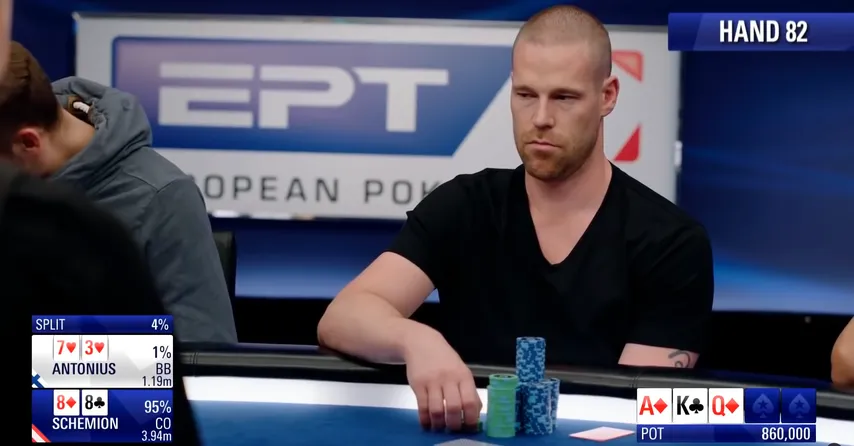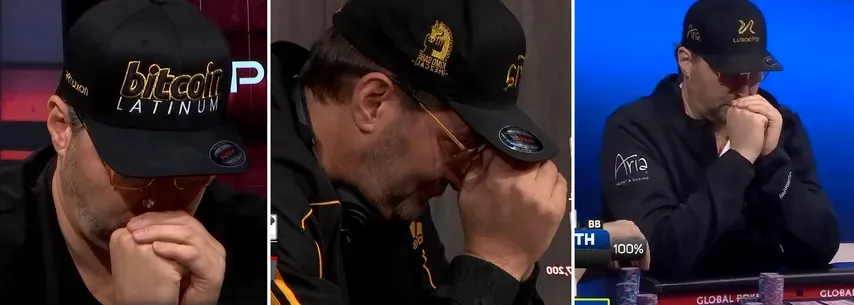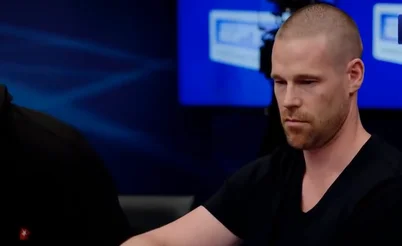During live games of Texas Holdem or any other poker game, you want opponents to have the absolute minimum amount of information. And so, a poker face is more than just a casual expression—it's a critical skill that can influence outcomes. Elizabeth Henry's recent work on Poker Face Defense Principles offers valuable insights for players looking to elevate their poker faces. Some of what you read in the research paper will be very intuitive to you, while other parts may be brand new.
At its core, the Poker Face Defense is a set of techniques designed to maintain a neutral, unreadable expression and demeanor during crucial moments. While rooted in poker, these principles extend far beyond the felt, finding applications in various high-pressure situations.
Key Aspects of Poker Face Defense:
- Facial Expression Control: Suppressing micro-expressions and maintaining a neutral countenance
- Body Language Management: Avoiding tell-tale movements and projecting a confident posture
- Vocal Tone Modulation: Speaking with consistent pitch and cadence to avoid revealing information
- Psychological Strategies: Cultivating emotional detachment and cognitive control

Tips for Building a Poker Face Defense
Looking to become a bit more unreadable? Work on the following areas of your live poker game.
1. Controlling Facial Expressions
Micro-expressions are extremely brief displays that we show, usually as a response to actions. An expression lasting for less than a total duration of 1/25 of a second. A twitch of the mouth or a quick frown are both examples of micro-expressions. If we aren't careful, our faces may show dozens of micro-expressions every minute.
To gain some level of control, players should "develop heightened observational skills to identify microexpressions in themselves and others." Regulating your emotions and mindfully controlling your facial muscles will also be helpful. Keeping a baseline expression, sometimes called a "blank slate," is another mechanism for suppressing micro-expressions.
Some players cover up their facial expressions in less conventional ways. Even now, long after the COVID-19 pandemic, masks are still seen in poker rooms. It's not always clear whether they are worn for medical reasons or concealing poker tells. Hoodies, scarves, and hands are also used to cover up player's faces. The poker community still debates the ethics of these methods. Some say it removes an important element from the game and makes it far less enjoyable for viewers.

Phil Hellmuth, known for his stunning number of WSOP bracelets and decades of success, has a strong opinion on masks at the table. He recently called out Ike Haxton for continuing to wear masks during live events. Ironically, Phil is also known for covering his own face during big moments, using his baseball cap and hands.
2. Body Language and Posture
We all need to move around from time to time, but at a poker table, movements sometimes tell a story. Your body can speak volumes even when your face remains stoic. Avoiding fidgeting, maintaining a relaxed yet confident posture, and controlling gestures are essential aspects of the Poker Face Defense. Players should focus on composure and control of their physical presence.
Avoid touching your cards postflop, shuffling, foot tapping, and other unnecessary movements. As with micro-expressions, observing your opponent's body language can help you understand your own movements. Get feedback from friends or record yourself on video to analyze later. It may be surprising to see all of the involuntary movements you make.
Online poker players don't have to worry about having a Poker Face Defense. They focus more on mental strategies, timing of their actions, and playing fundamentally sound poker. Some will find it much easier to play online, not having to worry about what their face or body is doing. For others, the physical aspects of live poker are what makes it so alluring.
- GipsyTeam's unique promotions
- Help with deposits and cashouts
- Access to private freerolls
- Round-the-clock support
- GipsyTeam's unique promotions
- Help with deposits and cashouts
- Access to private freerolls
- Round-the-clock support
- GipsyTeam's unique promotions
- Help with deposits and cashouts
- Access to private freerolls
- Round-the-clock support
- Уникальные акции от GipsyTeam
- Помощь с депозитами и кешаутами
- Доступ в закрытые фрироллы
- Круглосуточная поддержка
- Уникальные акции от GipsyTeam
- Помощь с депозитами и кешаутами
- Доступ в закрытые фрироллы
- Круглосуточная поддержка
- GipsyTeam's unique promotions
- Help with deposits and cashouts
- Access to private freerolls
- Round-the-clock support
- Уникальные акции от GipsyTeam
- Помощь с депозитами и кешаутами
- Доступ в закрытые фрироллы
- Круглосуточная поддержка
- GipsyTeam's unique promotions
- Help with deposits and cashouts
- Access to private freerolls
- Round-the-clock support
- GipsyTeam's unique promotions
- Help with deposits and cashouts
- Access to private freerolls
- Round-the-clock support
- GipsyTeam's unique promotions
- Help with deposits and cashouts
- Access to private freerolls
- Round-the-clock support
- GipsyTeam's unique promotions
- Help with deposits and cashouts
- Access to private freerolls
- Round-the-clock support
- GipsyTeam's unique promotions
- Help with deposits and cashouts
- Access to private freerolls
- Round-the-clock support
- GipsyTeam's unique promotions
- Help with deposits and cashouts
- Access to private freerolls
- Round-the-clock support
- GipsyTeam's unique promotions
- Help with deposits and cashouts
- Access to private freerolls
- Round-the-clock support
- GipsyTeam's unique promotions
- Help with deposits and cashouts
- Access to private freerolls
- Round-the-clock support
- GipsyTeam's unique promotions
- Help with deposits and cashouts
- Access to private freerolls
- Round-the-clock support
- GipsyTeam's unique promotions
- Help with deposits and cashouts
- Access to private freerolls
- Round-the-clock support
- GipsyTeam's unique promotions
- Help with deposits and cashouts
- Access to private freerolls
- Round-the-clock support
- GipsyTeam's unique promotions
- Help with deposits and cashouts
- Access to private freerolls
- Round-the-clock support
- GipsyTeam's unique promotions
- Help with deposits and cashouts
- Access to private freerolls
- Round-the-clock support
- GipsyTeam's unique promotions
- Help with deposits and cashouts
- Access to private freerolls
- Round-the-clock support
- GipsyTeam's unique promotions
- Help with deposits and cashouts
- Access to private freerolls
- Round-the-clock support
- Уникальные акции от GipsyTeam
- Помощь с депозитами и кешаутами
- Доступ в закрытые фрироллы
- Круглосуточная поддержка
- GipsyTeam's unique promotions
- Help with deposits and cashouts
- Access to private freerolls
- Round-the-clock support
- GipsyTeam's unique promotions
- Help with deposits and cashouts
- Access to private freerolls
- Round-the-clock support
- GipsyTeam's unique promotions
- Help with deposits and cashouts
- Access to private freerolls
- Round-the-clock support
- GipsyTeam's unique promotions
- Help with deposits and cashouts
- Access to private freerolls
- Round-the-clock support
- GipsyTeam's unique promotions
- Help with deposits and cashouts
- Access to private freerolls
- Round-the-clock support
- GipsyTeam's unique promotions
- Help with deposits and cashouts
- Access to private freerolls
- Round-the-clock support
- Уникальные акции от GipsyTeam
- Помощь с депозитами и кешаутами
- Доступ в закрытые фрироллы
- Круглосуточная поддержка
- GipsyTeam's unique promotions
- Help with deposits and cashouts
- Access to private freerolls
- Round-the-clock support
- GipsyTeam's unique promotions
- Help with deposits and cashouts
- Access to private freerolls
- Round-the-clock support
- Уникальные акции от GipsyTeam
- Помощь с депозитами и кешаутами
- Доступ в закрытые фрироллы
- Круглосуточная поддержка
- GipsyTeam's unique promotions
- Help with deposits and cashouts
- Access to private freerolls
- Round-the-clock support
- Уникальные акции от GipsyTeam
- Помощь с депозитами и кешаутами
- Доступ в закрытые фрироллы
- Круглосуточная поддержка
- Уникальные акции от GipsyTeam
- Помощь с депозитами и кешаутами
- Доступ в закрытые фрироллы
- Круглосуточная поддержка
- GipsyTeam's unique promotions
- Help with deposits and cashouts
- Access to private freerolls
- Round-the-clock support
- GipsyTeam's unique promotions
- Help with deposits and cashouts
- Access to private freerolls
- Round-the-clock support
- GipsyTeam's unique promotions
- Help with deposits and cashouts
- Access to private freerolls
- Round-the-clock support
- Уникальные акции от GipsyTeam
- Помощь с депозитами и кешаутами
- Доступ в закрытые фрироллы
- Круглосуточная поддержка
- GipsyTeam's unique promotions
- Help with deposits and cashouts
- Access to private freerolls
- Round-the-clock support
- GipsyTeam's unique promotions
- Help with deposits and cashouts
- Access to private freerolls
- Round-the-clock support
- GipsyTeam's unique promotions
- Help with deposits and cashouts
- Access to private freerolls
- Round-the-clock support
- GipsyTeam's unique promotions
- Help with deposits and cashouts
- Access to private freerolls
- Round-the-clock support
- Уникальные акции от GipsyTeam
- Помощь с депозитами и кешаутами
- Доступ в закрытые фрироллы
- Круглосуточная поддержка
- GipsyTeam's unique promotions
- Help with deposits and cashouts
- Access to private freerolls
- Round-the-clock support
- GipsyTeam's unique promotions
- Help with deposits and cashouts
- Access to private freerolls
- Round-the-clock support
3. Vocal Tone and Inflection
The way you speak can inadvertently reveal information about your hand or emotional state. Modulating your tone, pitch, and cadence is crucial for maintaining an effective poker face. Aim for a consistent, neutral delivery to avoid giving away any clues to your opponents.
The author of Poker Defense Principles advises us to control our voice, but there's an easier way. Many professionals will tell poker players not to speak at all when they are in a hand. Very few players have enough experience and understanding of "table talk." It presents many opportunities for us to slip up and deliver information to our opponents on a silver platter. If you are going to speak up, you must control the tone of your voice, choose which words to use, and have a goal in mind. On top of that, you can't forget about facial expressions or body language, making table talk a rather high-risk move.
Eric Persson's table talk doesn't always work out. However, in the clip below, he used it to rope Garrett Adelstein into a massive Ace-high call.
4. Psychological Strategies
The mental game is perhaps the most critical aspect of the Poker Face Defense since it has a trickle-down effect on your physical responses. Cultivating emotional detachment and cognitive control allows players to maintain composure under pressure. This involves managing stress, avoiding triggers, and developing a strategic mindset focused on long-term objectives rather than short-term emotional impulses.
Stress management is key and certain situations will trigger responses more than others. Over time, you will probably react less and less, as you become more familiar with poker scenarios. Did your pocket Aces get cracked by ? For beginners, such a tragedy might have lasting effects on their mood and mental state. Most pros learn to deal with these outcomes gracefully and stoically, though there are many exceptions.
Applying the Poker Face Defense
While these principles are fundamental to poker, they can be applied in various contexts, including business negotiations and personal interactions. However, it's crucial to adapt the approach to different settings, as the level of emotional detachment appropriate at the poker table may not be suitable in all situations. For example, keeping a blank expression for an entire business meeting might not have a positive effect on the outcome. But, in a job interview, being in control of nervous facial expressions could project confidence to your would-be employer.
Away from the poker table, apply your poker face delicately. Maintaining a consistent poker face can be mentally taxing and may lead to fatigue over extended periods. There's also a risk of being perceived as untrustworthy or manipulative if the technique is overused or applied inappropriately.
Mastering the Poker Face Defense can provide an edge in live poker games of all stakes. By developing control over facial expressions, body language, and vocal cues, players can effectively conceal their intent from opponents. However, successful application requires practice, self-awareness, and a nuanced understanding of when and how to deploy these techniques.
If you want to read the full research paper from Elizabeth Henry, you can find it on Google Scholar (https://scholar.google.com/scholar?hl=en&as_sdt=0,5&q=%22Elizabeth+Henry%22&scisbd=1).




















